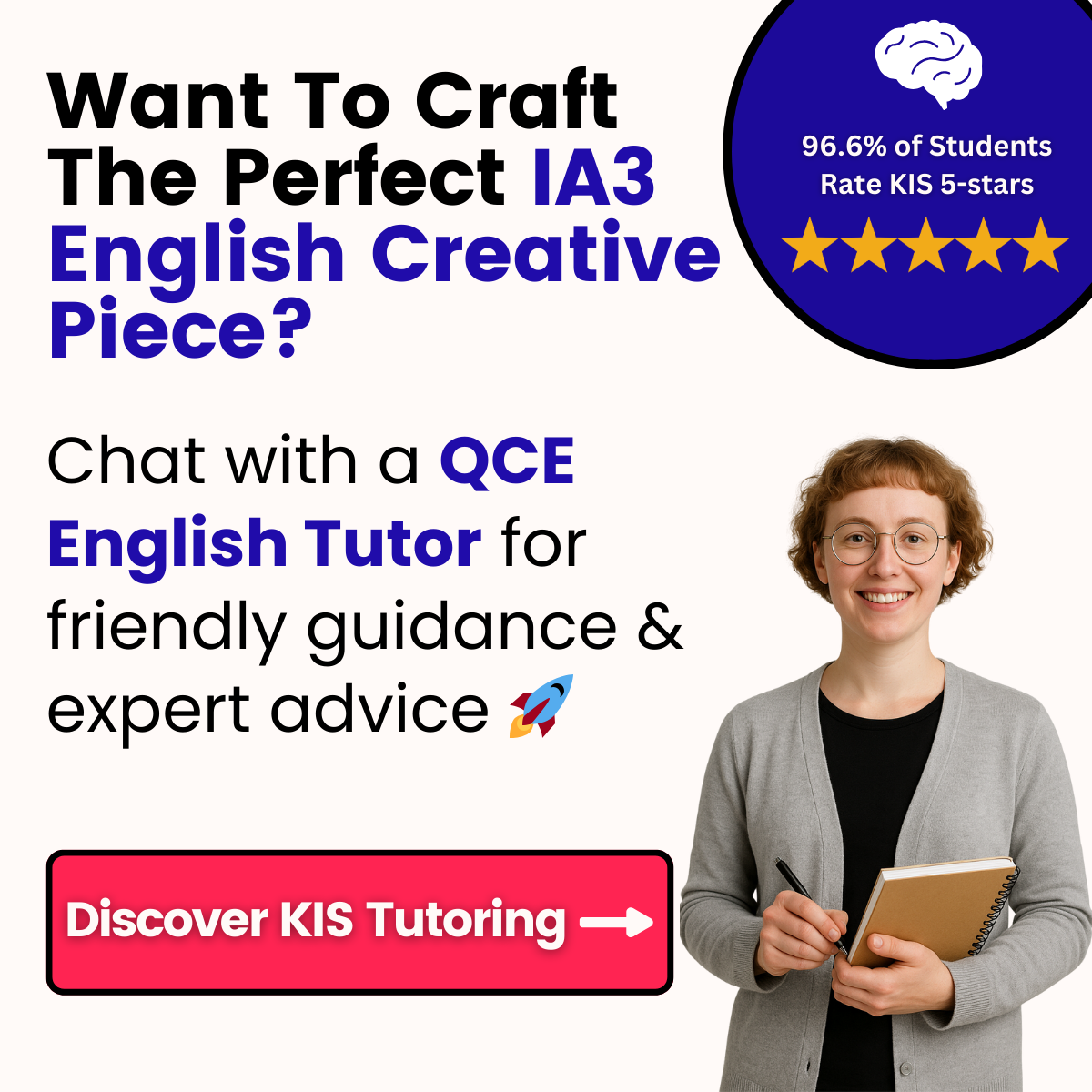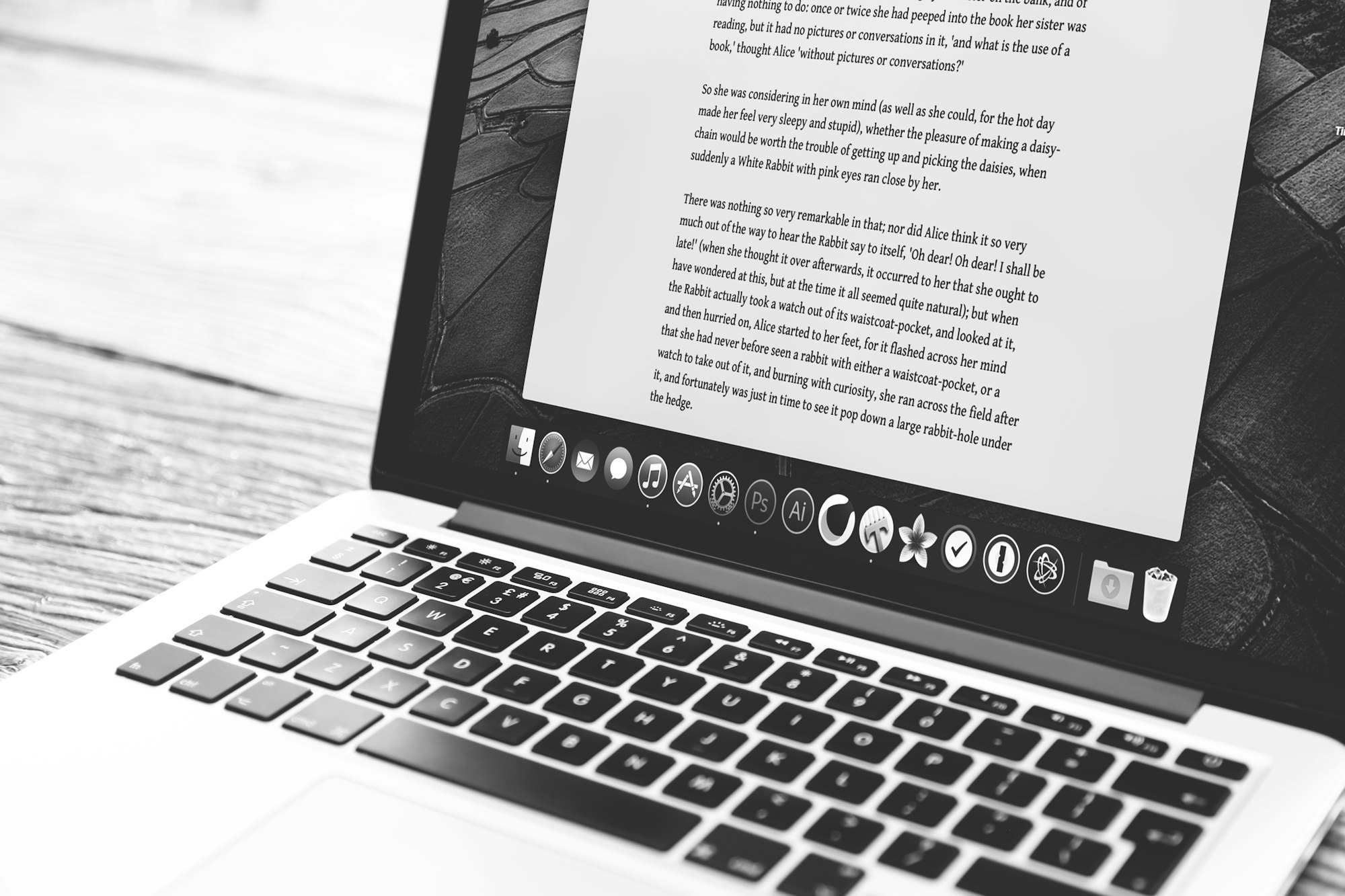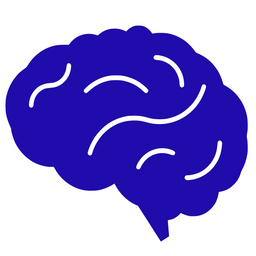The English IA3 task requires students to write under exam pressure. This means it is important to be well-prepared, and feel as comfortable as possible when you sit in an exam hall to write non-stop for a little over 2 hours.
This post covers everything you need to know to help you score a band 6 in the English IA3 Imaginative Response Task!
Table Of Contents:
- What Is The English IA3 Imaginative Response Task?
- How To Choose The Right Text For Your English IA3 Imaginative Piece?
- How Should You Plan For The English IA3 Imaginative Task?
- What Should You Include In An Imaginative Story?
- How Should You Structure A Imaginative Story?
- Final Tips & Tricks For English IA3
- Conclusion
- FAQs
- Join 5000+ KIS Students — Start Your Free Trial Lesson

What Is The English IA3 Imaginative Response Task?
The QCAA marks the English IA3 based on these three criteria:
- Write an imaginative response to a literary text (most likely a poem or short story)
- Demonstrate your knowledge of the craft of writing
- Prompt critical and emotional responses from the reader
Rather than analysing a literary text, this task requires you to creatively develop an aspect of a text. You will be:
- Given one week’s notice of the texts
- Required to write a response of 800-1000 words
- Given 15 minutes to plan, and 2 hours to complete the exam
How To Choose The Right Text For Your English IA3 Imaginative Piece
- Read through of all the provided texts and decide which one you feel most connected to, and/or understand the best.
- Once you’ve chosen your text, annotate and break down the themes and messages that flow through it. Annotating the text helps you to understand key aspects that may not have been apparent to you before.
How Should You Plan For The English IA3 Imaginative Task?
1. Generate Ideas
Your ideas for the task can be inspired by a variety of things:
- Personal Experiences (things that have changed your perspective)
- Ideas that resonate with you
- Your imagination
- Observations about people, places, and events
- Re-telling existing stories, legends or myths, but putting your twist on them
If you have too many ideas, you can proceed to write multiple plans for the various ideas. This allows you to see your ideas more clearly, and be able to make a more informed decision on which idea would be best for you to write. Ask your peers and/or teachers for advice on your story idea too! Getting a second opinion can help improve and/or reaffirm your ideas.
2. Structure your story
Structure your story based on the elements in Freytag’s Pyramid, and plan how your story fits into this structure:
What Should You Include In An Imaginative Story?
Let me break down the important aspects of a short story that you should include in your assessment:
1. Character
- Every character is important when writing a short story, so be purposeful with all their actions. The characters are how you can most easily display emotions that you would like to convey.
- I recommend having 1 main character, and a maximum of 3 characters in your short story. This ensures that you stay within the word count, and the reader can still stay connected to the main character and their journey.
- There are two main aspects to creating a good main character:
- Make sure they have Depth: Does your character have emotional responses (i.e. are they a rock or are they emotionally vulnerable?)? To help a character display emotion, look back to how you or people in your lives have reacted when in different situations.
- Building Relationships: How does this character act towards others, how do they treat people above or below them? If somebody cries to your protagonist/antagonist, how do they react? Do they console them, or do they use 'tough love'? Do they start crying as well?
- Characters can be inspired by the people and relationships you have in real life.
2. Theme
- The theme is the concept you want your story to focus on:
- Is it identity?
- Is it family relationships?
- Is it the overall feeling of loss or accomplishment?
- The theme is the basis of what makes your reader feel, which is the overall goal of a short story. You want to elicit some emotion from your reader.
3. Imagery and Foreshadowing
- Foreshadowing allows the writer to hint at what happens later in a story. Some tips to utilise imagery to foreshadow are:
- Using subtle clues: You can sprinkle some context clues throughout your story.
- Scene Description: The use of scene description can do wonders. A very common device is using darkness and light to portray your character's mood (feeling happy/sad).
- Timing and Balance: The timing and balance for imagery and foreshadowing is quite tough to master at times, you need to know where and when to use it. A common place for these devices is the beginning, and the climax.
How Should You Structure A Imaginative Story?
1. Exposition (orientation)
- Here, you introduce the setting, and the main character and potentially foreshadow what is to come.
- I recommend starting with a ‘sizzling’ start. This can be in the form of a detailed description foreshadowing something later in the story, or an event to introduce to the readers your story straight away.
2. Inciting Incident Leading to Rising Action
- Introduce 1 to 3 different obstacles, or some kind of barriers, that affect your main character.
- These obstacles can be:
- Social (interpersonal)
- Emotional (fear, trauma, limiting beliefs)
- Moral dilemmas (forcing characters to wrestle with ethical decisions)
- Physical (locked area, physical fight, etc)
3. Climax/Conflict
- There are a two different types of conflict:
- Internal – struggles with challenging decisions, moral dilemmas, or conflicting desires
- External – conflicts involving one's struggle against societal, cultural or situational forces
- Whatever your conflict is, it should ideally transform your character and/or invite the reader to reflect on your ideas and concepts.
- This means that as characters grapple with their core beliefs, the readers are also invited to experience the same transformation in their thinking.
- The choices your character makes in the face of conflict reflect their inner struggles, desires and motivations, inviting readers to appreciate your narrative's perspective on the human condition
- To convey conflict, I suggest breaking it down into three parts, and utilising ‘show not tell’ throughout:
- What is happening in the story towards the main character?
- What emotions are the characters feeling (frustration, jealousy etc)
- Why/how are they feeling them (crying, tantrums etc)?
This is the most important part of your story. Without conflict, there is no point to the story.
4. Falling Action
- This section connects the climax and resolution.
- Ensure that the climax is resolved in a manner that isn’t too fast or too slow, and in a method the reader can enjoy.
- The flow of the narrative should naturally have its falling action, however it should also be identifiable in your short story.
5. Resolution
- Ensure that there are no loose ends (we aren’t writing a part 2), or any classic endings that will destroy our reader’s hearts ("I woke up ,and it was all a dream", or your main character dies).
- It is important to have a sound ending where your readers can be left satisfied with the story they have read.
- This section can also almost explicitly have the theme of the story shine through, making it clear on the progression that has been made.
Final Tips & Tricks For English IA3
- I strongly recommend writing your story before walking into the exam. This enables you to have confidence that your story ‘works’, and can be written within the time limit.
- This task is meant to be fun, so have fun with it!
- Many people memorise their story before going into exam conditions, which is a good idea. If you need tips on how to memorise the essay, check out this KIS Academics guide.
- Fine-tune your story! Break down each paragraph, each sentence, and even each word to make sure they all contribute meaning to your story.
- Have someone else read your story, and give you feedback. They could be a peer, sibling and/or a parent. Or, you can utilise KIS Academics' Essay writing service.
Conclusion
IA3 is very different from most other essays, because it requires you to be creative. Do not be afraid to try new things; just let your ideas run wild. As long as you have fun, use proper grammar, and keep my tips in mind, you will be able do well!
After more English resources? Check these out!👇


FAQs
1. How much is the IA3 worth towards my English grade?
- 25% of your overall English mark
2. What are some tips on memorising my English IA3 for the exam?
- When trying to memorise, start small instead of straight away looking to learn your entire response by heart.
- Begin with your first sentence, then your first two sentences, and progress to a paragraph.
- Solidify your memory of that paragraph before moving on to the next paragraph.
- Build a memory of your response in a consistent method, and it will be much easier to learn.
3. Where can I find an example of an IA3 English Imaginative written response?
- There’s an annotated IA3 example on the QCAA website.
- This helps to understand the ISMG and what your marker is looking for.
Written by KIS Academics Tutor for QCE Physics, Specialist Mathematics and Mathematical Methods, Ragulan Gnanavel. Ragulan is currently pursuing a Bachelor of Actuarial Studies and Commerce at UNSW. He has outstanding credentials as a tutor, and you can view Ragulan’s profile here and request him as a tutor.
What Our Students & Parents Say
600+ Five-Star reviews across all our tutoring programs — hear why below !👇






